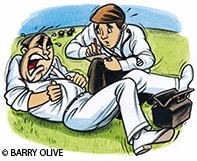Innocence revisited – 10
This month we offer surgical treatment...
Compiled by Dr John Ellard
The first principle
The first principle to establish about surgical treatment is that when praise about the result is offering, one should accept it. You don’t even need to make an incision – on this occasion, Dr Tertius avoided the trap and grabbed the praise.
At one time, part of my workload was being doctor to the local bowling club, where heart attacks happened often enough to make such an appointment worthwhile. A morning surgery was interrupted very urgently one day. Would I drop everything and run – a man had collapsed with a shocking pain. At that time in my career I don’t believe I had ever seen such a case but a fairly rapid examination convinced me that this man had a leaking aneurysm. Having called an ambulance, I scribbled a note to the admitting doctor, ‘Herewith Mr Joe Blow with a leaking aortic aneurysm’, and quickly signed it.
The rest of the story is secondhand from a friend who worked at the hospital.
The surgeon of the day strode in, and laughed heartily at my scribbled note.
‘Typical bloody GP’, he chortled, ‘sure to be wrong!’
Then, leaning towards the patient, who was obviously unwell, he pulled down the man’s pants and started prodding the abdomen. The result was instantaneous. The aneurysm ruptured finally and pandemonium ensued. Despite everything, the patient lived and he later sent me a grateful letter.
The surgeon avoided me.
The second principle
The second principle is essentially the same as the first: grab praise about the result without being too preoccupied with detail.
Dr Cassandra knew what to do:
Many years ago I was a resident medical officer at the Brisbane General Hospital, then the largest hospital in the Southern Hemisphere, with its 1200 beds serviced by approximately 25 residents. That is, if the hospital was lucky enough to get them, as at that time it was not a teaching hospital. We were certainly overworked, but offsetting this we gained tremendous experience, and the pay, at 150 pounds per annum, was almost double that at the Melbourne Hospital.
Although I was the surgical resident on duty, I had not yet seen a tonsillectomy performed. Later, when I was doing my stint in the children’s section, I took part in the ghastly, but what we then regarded as hilarious, routine of seeing how many guillotine tonsillectomies we could do in the shortest time. The child was put under with ethyl chloride, gag put in, snip–snip, and then scrape the adenoids, apply iodine-soaked sponges with pressure to the fossae – next, please.
One night I was paged to report to the ear, nose and throat ward to see a patient who was bleeding after a tonsillectomy. I approached the young man with great trepidation, noticing the bloodstains on his chin and a mouth that appeared full of
blood clot. I ordered the mandatory – but useless – injection (I’ve forgotten its name) which was supposed to stop the bleeding. Believe it or not, but there was an instrument called a tonsillar clamp, a sort of broadened sponge forceps for the specific purpose of stopping the bleeding. Stuff the fossa with gauze, insert one blade over the gauze, the other blade outside over the region of the mandible, and close the blades –with pressure.
When this failed, the next step was to clean out the clot, put a piece of rolled gauze in the fossa and suture it in.
When this failed, as it always did, you tried to do what later became the first step, that is, to locate and ligature the bleeding point.
Have you tried this procedure in a bed, using cocaine spray, and with the patient spitting out blood all the time? The endurance of the young man was magnificent. Finally, after nearly two hours’ work, Luck favoured me – the ENT resident walked in to do his night round and he sutured the bleeding point.
Many months later, while I was shopping in Adelaide Street, I was accosted by a young man, who said, ‘Hi, Doc. Don’t you remember me?’
When I admitted to a poor memory, he replied, ‘But you saved my life when I was bleeding to death after my tonsil operation and you stopped it’.
Nobly I accepted the accolade, and walked on.
A cure for an uncommon cough
Praise received, one should do something. Draining aneurysms for the relief of cough could be a good start – let Dr Quartus tell us how he did it:
When I was district medical officer and surgeon at a hospital in Uganda, I was asked by one of my colleagues to operate on a woman who had a retrosternal goitre.
The history was very strange. Among other duties, my colleague was in charge of the tuberculosis wards. This African woman was an inpatient of his female acute pulmonary tuberculosis ward because of her chronic cough, and had been there some time. He became suspicious when she showed no signs of pulmonary tuberculosis and chest x-rays were normal. He then discovered a mass pressing on the trachea and oesophagus. At barium swallow he provisionally diagnosed retrosternal goitre. This seemed reasonable, but as our pathology facilities were scanty no definitive diagnosis was made.
I duly operated, and was much disconcerted when, trying to lift the tumour out with my forefinger, the tumour ruptured and blood rushed out. After haemostasis was achieved with two clamps, I realised that here was an aneurysm of the right subclavian common carotid junction. The vessels were tied, and the wound closed. There was still a good pulse in the right arm. Not only did the woman have an uneventful recovery; her cough was also cured.
I had nightmares for days afterwards…
Next month we proceed to the eventual outcome of all medical intervention – death.

